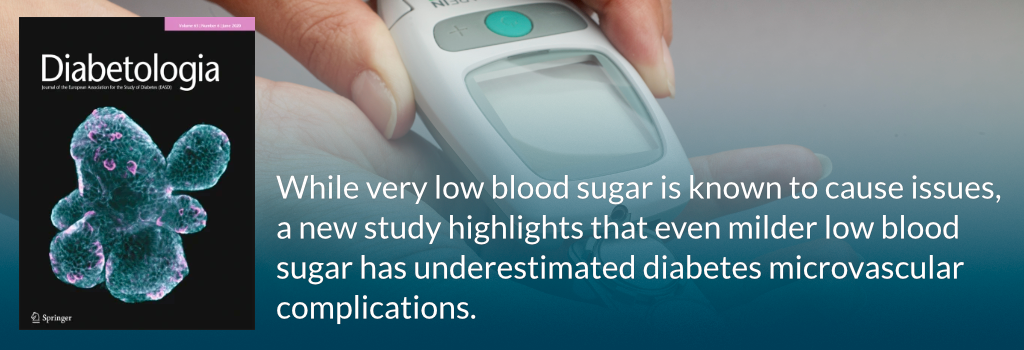05 Aug 2024

A new study has identified that hypoglycaemia (low blood sugar) is associated with an increased risk of adverse events across several body systems in diabetes, such as neuropathy, kidney disease, retinal disorders, and depression.
The study, “Estimating risk of consequences following hypoglycaemia exposure using the Hypo-RESOLVE cohort: a secondary analysis of pooled data from insulin clinical trials” (Mellor et al., July 2024) aimed to create and use a dataset of pooled clinical trials in people with type 1 or type 2 diabetes to examine the association of exposure to all hypoglycaemia episodes across the range of severity with incident event outcomes: death, CVD, neuropathy, kidney disease, retinal disorders, and depression.
Most research about low blood sugar (hypoglycaemia) in diabetes focuses on very low levels that can impact the heart and risk of death. But there isn’t as much known about milder low blood sugar (levels below 70 mg/dl and 54 mg/dl) and problems with small blood vessels (microangiopathy), especially nerve damage (neuropathy).
First, this study found an unexpected connection between low blood sugar episodes and higher chances of getting neuropathy. Diabetes-related nerve, eye, and kidney damage were thought to be linked only to ongoing high blood sugar.
Second, the rates of neuropathy reported in the clinical trials included here were relatively low – 4.3% for type 1 diabetes and 6.8% for type 2 diabetes. This suggests neuropathy may be undercounted in people with diabetes overall.
Low blood sugar can increase inflammation and oxidative stress levels in the body. Research shows when blood sugar rises after low levels, there is more neuron superoxide made and oxidative damage. This swing in blood sugar seems especially harmful to nerve cells and adds to oxidative stress.
No evidence was found that blood sugar needs to drop below a certain level (3.9 mmol/l or 70 mg/dl) to cause harm. Risk just kept increasing with lower levels.
So it’s important to prevent even mild low blood sugar episodes. This protects quality of life now and prevents problems later like neuropathy.
In summary, while very low blood sugar is known to cause issues, this study highlights milder low blood sugar often underestimated effects on diabetes microvascular complications. More research is still needed to understand how mild low blood sugar leads to neuropathy and find ways to prevent it.
Methods:
Data from 84 trials with 39,373 participants were pooled. For event outcomes, time-updated Cox regression models adjusted for age, sex, diabetes duration, and HbA1c were fitted to assess the association of outcomes with cumulative exposure to hypoglycaemia episodes and with exposure to a recent hypoglycaemia episode within the last 10 days.
Results:
- In type 1 diabetes, cumulative exposure to hypoglycaemia episodes of any level was associated with higher risks of neuropathy, kidney disease, retinal disorders, and depression. The risk ratio for neuropathy was 3.048 (1.837, 5.057).
- For type 2 diabetes, cumulative exposure to hypoglycaemia episodes of any level was associated with higher risks of death, acute CVD, kidney disease, retinal disorders, and depression. The risk ratio for neuropathy was 2.539 (1.746, 3.691).
Conclusions:
These data are consistent with hypoglycaemia being associated with an increased risk of adverse events across several body systems in diabetes. These associations are not confined to severe hypoglycaemia requiring assistance.
Read more
